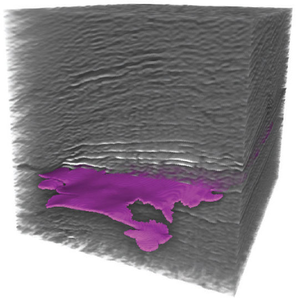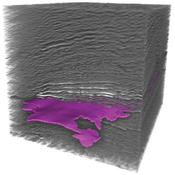Information
- Publication Type: Conference Paper
- Workgroup(s)/Project(s): not specified
- Date: March 2010
- Location: Taipei, Taiwan
- Lecturer: Daniel Patel
- Booktitle: Proceedings of IEEE Pacific Visualization 2010
- Pages: 73 – 80
- Keywords: volume visualization, horizon extraction, seismic data
Abstract
Seismic horizons indicate change in rock properties and are central in geoscience interpretation. Traditional interpretation systems involve time consuming and repetitive manual volumetric seeding for horizon growing. We present a novel system for rapidly interpreting and visualizing seismic volumetric data. First we extract horizon surface-parts by preprocessing the seismic data. Then during interaction the user can assemble in realtime the horizon parts into horizons. Traditional interpretation systems use gradient-based illumination models in the rendering of the seismic volume and polygon rendering of horizon surfaces. We employ realtime gradientfree forward-scattering in the rendering of seismic volumes yielding results similar to high-quality global illumination. We use an implicit surface representation of horizons allowing for a seamless integration of horizon rendering and volume rendering. We present a collection of novel techniques constituting an interpretation and visualization system highly tailored to seismic data interpretation.Additional Files and Images
Additional images and videos
Additional files
 film clip:
Animation from Phong shading to forward-scattering shading
film clip:
Animation from Phong shading to forward-scattering shading
Weblinks
No further information available.BibTeX
@inproceedings{patel-2010-SVV,
title = "Seismic Volume Visualization for Horizon Extraction",
author = "Daniel Patel and Stefan Bruckner and Ivan Viola and Eduard
Gr\"{o}ller",
year = "2010",
abstract = "Seismic horizons indicate change in rock properties and are
central in geoscience interpretation. Traditional
interpretation systems involve time consuming and repetitive
manual volumetric seeding for horizon growing. We present a
novel system for rapidly interpreting and visualizing
seismic volumetric data. First we extract horizon
surface-parts by preprocessing the seismic data. Then during
interaction the user can assemble in realtime the horizon
parts into horizons. Traditional interpretation systems use
gradient-based illumination models in the rendering of the
seismic volume and polygon rendering of horizon surfaces. We
employ realtime gradientfree forward-scattering in the
rendering of seismic volumes yielding results similar to
high-quality global illumination. We use an implicit surface
representation of horizons allowing for a seamless
integration of horizon rendering and volume rendering. We
present a collection of novel techniques constituting an
interpretation and visualization system highly tailored to
seismic data interpretation.",
month = mar,
location = "Taipei, Taiwan",
booktitle = "Proceedings of IEEE Pacific Visualization 2010",
pages = "73--80",
keywords = "volume visualization, horizon extraction, seismic data",
URL = "https://www.cg.tuwien.ac.at/research/publications/2010/patel-2010-SVV/",
}


 Paper
Paper
